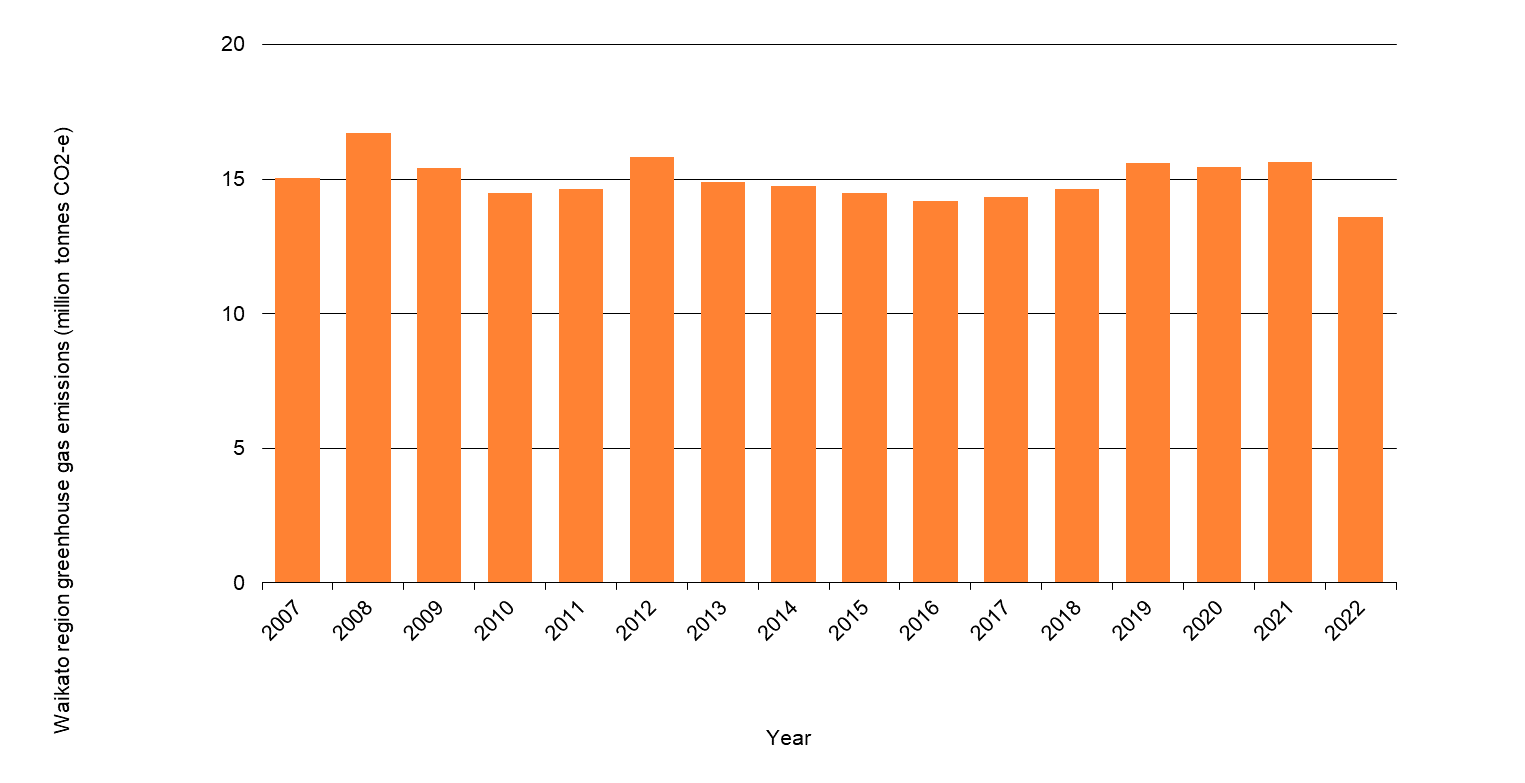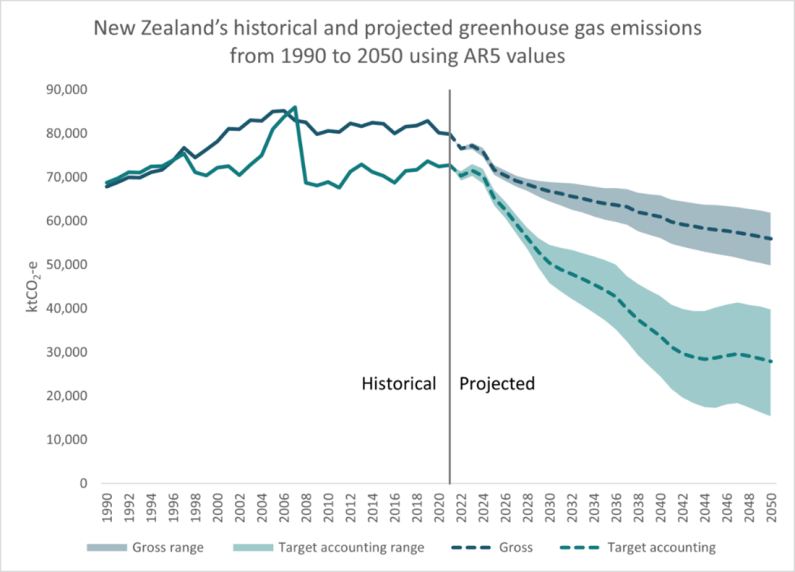Greenhouse gases

 GREENHOUSE GASES
GREENHOUSE GASES
| NO SIGNIFICANT CHANGE |
(note: trend indicator above is relative to 2007 WPI baseline year.)
Annual greenhouse gas emission levels appear to have stabilised, subject to annual fluctuations. Substantial decreases are needed in the coming years to support the achievement of national and regional targets.
This indicator shows the trend in total greenhouse gas emissions based on Statistics New Zealand’s annual regional greenhouse gas emissions estimates. This is supplemented by information from an inventory of the Waikato region’s community-scale greenhouse gas emissions which is compiled every three years.
Why is this indicator important?
Climate change is an issue requiring urgent collective action at the local, regional, national and international levels. According to the Intergovernmental Panel on Climate Change (Sixth Assessment Report, p. 63), human-induced climate change is a consequence of more than a century of net GHG emissions from unsustainable energy use, land-use and land use change, lifestyle and patterns of consumption and production.
The effects of these gases have been documented in compelling evidence of climate change gathered from scientific observations of changes to the atmosphere, land, oceans and cryosphere (for example, ice core records). There is evidence of climate change effects, including raised temperatures and sea levels and increased frequency of extreme weather events. The occurrence of these changes is projected to become more pronounced, and the rate of change more rapid over time. Changes in climate can have major impacts on our safety, health, economy and infrastructure, and where and how we live.
Future generations will be confronted with increasingly severe impacts including rising temperatures, more extreme weather, sea level rise and disruption to marine and land ecosystems.
Waikato region greenhouse gas emissions (million tonnes CO2 equivalents)

| Year | Waikato regional total gross greenhouse gas emissions (million tonnes CO2 equivalent) |
| 2007 | 15.1 |
| 2008 | 16.7 |
| 2009 | 15.4 |
| 2010 | 14.5 |
| 2011 | 14.6 |
| 2012 | 15.8 |
| 2013 | 14.9 |
| 2014 | 14.7 |
| 2015 | 14.5 |
| 2016 | 14.2 |
| 2017 | 14.3 |
| 2018 | 14.6 |
| 2019 | 15.6 |
| 2020 | 15.4 |
| 2021 | 15.7 |
| 2022 | 13.6 |
Note: Excludes land use or loss of soil carbon from activities such as peat drainage (estimated to be 1.5Mt CO2e per year).
What is this indicator telling us?
- According to Statistics New Zealand’s regional greenhouse gas emissions estimates, activities within Waikato region’s boundaries generated approximately 13.6 million tonnes of carbon dioxide equivalent (Mt CO2e) in 2022, compared to 15.1 in 2007. Annual estimates have fluctuated between a high of 16.7 near the start of the series in 2008 and a low of 13.6 in the latest year 2022.
- Compared to all other regions, Waikato is New Zealand’s highest emitter of carbon dioxide equivalents (CO2e). According to Stats NZ data, in 2022 the Waikato region had the second highest emissions of methane (behind Canterbury), the highest emissions of nitrous oxide, and second highest for carbon dioxide (behind Auckland). Agriculture contributes more than half of Waikato’s CO2e emissions. In 2022, 43 percent of Waikato’s total emissions were from carbon dioxide and a further 44 percent from methane.
- According to Waikato Regional Council’s latest regional greenhouse gas inventory for 2021/22, on a per capita basis, Waikato’s agricultural emissions are more than double the national per capita average. Previously, the region’s exotic production forests sequestered more than double the national average. However, in the latest inventory, regional sequestration is lower per capita than the national average due to high harvest volumes.
- Due to its emissions profile, the Waikato region needs to focus its reduction efforts on agriculture as well as consider options for maintaining or increasing its carbon removal potential, through a mixture of production and protection forests using both exotic and indigenous species according to land characteristics and capability. Within agriculture, a focus on methane emissions reduction is needed since it makes up about 80% of agricultural emissions.
- Waikato Regional Council’s per capita net emissions estimates (including forestry) at the territorial authority level indicate that in 2021/22, Waitomo had the highest rate at approximately 200 tonnes CO2e per capita. However, this was mostly due to the impacts of forestry in the Waitomo District during this period. Other high emitting districts per capita are Ōtorohanga, Matamata-Piako, Hauraki and Waikato District. Taupō is at the other extreme with a net emissions reduction of approximately -14 tonnes CO2e per capita. These are not intended as a benchmark between territorial authorities but simply as an indicative framework of reference to understand the range of differences between emissions profiles.
- According to the Ministry for the Environment’s New Zealand Greenhouse Gas Inventory, national gross emissions peaked in 2006, were relatively stable through to 2019, and have been declining since 2019. The declines between 2019 and 2020 were largely attributed to impacts from the COVID-19 pandemic across most sectors, especially Energy. In 2021, the COVID-19 pandemic continued to have an impact on the Energy sector, however, the decrease in gross emissions was largely driven by decreases in emissions from Agriculture. Decreases continued in 2022, however, these were not driven by the COVID-19 pandemic.
- In 2022, New Zealand’s gross emissions were 78.4 million tonnes of CO2-e. Annual emissions remain 14 per cent higher than in 1990, the base year for United Nations Framework Convention on Climate Change reporting.
- Comparing emissions growth to real GDP over time suggests there has been a relative decoupling of economic growth from emissions growth in recent decades. For example, New Zealand’s real GDP increased at an average annual rate of 3.1 per cent over the period 1990 to 2015 while emissions increased at an average 0.9 per cent per annum over the same period (0.5 per cent for primary industries, 1.2 for goods-producing industries, 2.2 for service industries) (source: Statistics New Zealand’s Environmental-economic accounts 2018).
- The Ministry for the Environment publishes projections of New Zealand’s greenhouse gas emissions as part of its climate change commitments. Latest projections show that New Zealand’s target accounting (net) emissions are projected to remain steady in the early 2020s, before declining to 59.3 per cent below the 1990 national emissions level in 2050. Gross emissions are projected to steadily decrease to 17.5 per cent below 1990 levels in 2050. Gross emissions are projected to reduce across all sectors.
New Zealand’s historical and projected greenhouse gas emissions from 1990 to 2050

DATA SOURCE AND SUPPORTING INFORMATION
Estimates of regional greenhouse gas emissions since 2007 are produced by Statistics New Zealand by allocating national emissions by residence of economic units and household (refer www.stats.govt.nz/methods/about-regional-greenhouse-gas-emissions-statistics). For each release, the historical series is recalculated as input data is revised, including both national-level benchmarks and indicators used to allocate to regions. This also allows methodological changes that improve how SNZ allocate to regions to apply to the entire time series.
Waikato regional data are also available from the Waikato Region Comprehensive Greenhouse Gas Inventory. The first period for the regional inventory is 2015-16, followed by 2018-19 data published in mid-2020, and 2021-22 data which was made available through an online dashboard in late 2023. The regional inventory was compiled following the Global Protocol for Community-Scale Greenhouse Gas Emissions Inventories (GPC), which is considered best practice for community-based inventories.
Supplementary to the 2021-22 regional GHG inventory, is the organic soil greenhouse gas emissions accounting for the Waikato region. This is a Waikato Regional Council report outlining Waikato regional emissions from organic ‘peat’ soils. Final methods estimate organic soils emissions generate 1.5 Mt CO2e per year.
Starting from 2018-19, individual emissions inventories have also been prepared by Waikato Regional Council for each of the 10 territorial authority areas of Waikato region: Hamilton City, Waikato, Hauraki, Thames Coromandel, Waitomo, Matamata Piako, Otorohonga, Waipā, South Waikato and Taupō. This was the first attempt to provide districts emissions breakdown and the expectation is that the insights will enable collaborations and actions for climate mitigation. Urban Hamilton City Council agriculture and forestry results carry some uncertainty due to downscaled inventory data and should be viewed as indicative.
Waikato Regional Council’s current process of updating the regional emissions inventory every three years is presently under review.
National data are published annually in April through the Ministry for the Environment (MfE) website – New Zealand’s Greenhouse Gas Inventory. Summary data can be sourced from the Interactive Emissions Tracker data (gross emissions, time series). Figures relate to New Zealand’s annual total greenhouse gas emissions (CO2 equivalent). Total emissions include those from the energy, industrial processes, solvent and other product use, agriculture and waste sectors, but do not include net removals from the ‘LULUCF’ sector (Land Use, Land Use Change and Forestry). New Zealand’s total (and net) emissions under the Climate Change Convention from 1990 to most recent year are plotted in the Inventory Report, and latest figures are cited and tabulated in the text and downloadable.
Information on the link between greenhouse gas emissions and GDP growth are from Statistics New Zealand’s Environmental-economic accounts 2018: www.stats.govt.nz/information-releases/environmental-economic-accounts-2018.
Projections of New Zealand’s greenhouse gas emissions are published in national communication and biennial reports tracking progress towards meeting internationally-agreed climate change commitments: https://environment.govt.nz/site-search/?keyword=projected%20greenhouse
Update details: Annual regional data release in September.
Customised data request requirements: Nil
DATA AVAILABILITY – OTHER THAN WAIKATO REGION:
Territorial Authority (TA) disaggregation: Yes (WRC estimates).
Other regions: Yes (but not comparable due to differing region size, population density, natural features etc)
New Zealand: Yes
Other countries/ Organisation for Economic Co-operation and Development (OECD): Yes


To ask for help or report a problem, contact us
Tell us how we can improve the information on this page. (optional)